Non-Steady State NMR Effect and Application on Time-Varying Magnetic Field Measurement
Abstract
:1. Introduction
2. The NSS-NMR Effect and Its Numerical Simulation Result
2.1. The NSS-NMR Effect
2.2. Numerical Simulation Result of the NSS-NMR Effect
3. The NSS-NMR Experimental Scheme
3.1. The Time-Varying Magnetic Field and the Experimental System
3.2. The Probe Design and Signal Processing Scheme
3.2.1. The Coil Structure Optimization
3.2.2. The Equivalent Circuit Parameters Extraction for the Orthogonal Dual-Coil Probe
3.2.3. Dual-Port Matching for the Orthogonal Dual-Coil Probe
3.2.4. Signal Processing Scheme
4. Processing Results
5. Conclusions
Author Contributions
Funding
Institutional Review Board Statement
Informed Consent Statement
Data Availability Statement
Conflicts of Interest
References
- Zou, S.; Zhang, H.; Chen, X.; Fang, J. In-situ triaxial residual magnetic field measurement based on optically-detected electron paramagnetic resonance of spin-polarized potassium. Measurement 2022, 187, 110388. [Google Scholar] [CrossRef]
- Oida, T.; Ito, Y.; Kamada, K. Detecting rotating magnetic fields using optically pumped atomic magnetometers for measuring ultra-low-field magnetic resonance signals. J. Magn. Reson. 2012, 217, 6–9. [Google Scholar] [CrossRef]
- Kim, C.G.; Ryu, K.S.; Woo, B.C.; Kim, C.S. Low magnetic field measurement by NMR using polarized flowing water. IEEE. Trans. Magn. 1993, 29, 3198–3200. [Google Scholar] [CrossRef]
- Wang, X.; Zhu, M.; Xiao, K.; Guo, J.; Wang, L. Static weak magnetic field measurements based on low-field nuclear magnetic resonance. J. Magn. Reson. 2019, 307, 106580. [Google Scholar] [CrossRef]
- Frait, Z.; Fraitová, D. Measurement of magnetic field intensity by means of NMR. I. Accuracy of measurement. Czechoslov. J. Phys. B 1977, 27, 1292–1305. [Google Scholar] [CrossRef]
- Switala, L.E.; Black, B.E.; Mercovich, C.A.; Seshadri, A.; Hornak, J. An electron paramagnetic resonance mobile universal surface explorer. J. Magn. Reson. 2017, 285, 18–25. [Google Scholar] [CrossRef]
- Kittell, A.W.; Camenisch, T.G.; Ratke, J.J.; Sidabras, J.W.; Hyde, J.S. Detection of undistorted continuous wave (CW) electron paramagnetic resonance (EPR) spectra with non-adiabatic rapid sweep (NARS) of the magnetic field. J. Magn. Reson. 2001, 211, 228–233. [Google Scholar] [CrossRef] [Green Version]
- West, M.E.; Sesti, E.L.; Willmering, M.M.; Wheeler, D.D.; Ma, Z.L.; Hayes, S.E. Describing angular momentum conventions in circularly polarized optically pumped NMR in GaAs and CdTe. J. Magn. Reson. 2021, 327, 106980. [Google Scholar] [CrossRef]
- Zanche, N.D.; Barmet, C.; Nordmeyer-Massner, J.A.; Pruessmann, K.P. NMR probes for measuring magnetic fields and field dynamics in MR systems. Magn. Reson. Med. Sci. 2008, 60, 176–186. [Google Scholar] [CrossRef]
- Blanchard, J.W.; Wu, T.; Eills, J.; Hu, Y.; Budker, D. Zero-to ultralow-field nuclear magnetic resonance J-spectroscopy with commercial atomic magnetometers. J. Magn. Reson. 2020, 314, 106723. [Google Scholar] [CrossRef]
- Bloch, F.; Hansen, W.W.; Packard, M. Nuclear induction. Phys. Rev. 1946, 70, 460–475. [Google Scholar] [CrossRef] [Green Version]
- Stork, H.; Bontemps, P.; Rikken, G.L. NMR in pulsed high-field magnets and application to high-Tc superconductors. J. Magn. Reson. 2014, 234, 30–34. [Google Scholar] [CrossRef]
- Chen, W.; Ma, H.; Yu, D. Broadband Continuous Nuclear Magnetic Resonance Signal in a Pulsed Magnetic Field: Numerical Solutions of Bloch Equations under Radio Frequency Irradiation. Appl. Magn. Reson. 2016, 47, 41–52. [Google Scholar] [CrossRef]
- Chen, W.; Ma, H.; Yu, D.; Zhang, H. SVD-Based Technique for Interference Cancellation and Noise Reduction in NMR Measurement of Time-Dependent Magnetic Fields. Sensors 2016, 16, 323. [Google Scholar] [CrossRef] [Green Version]
- Chen, W.; Ma, H.; Yu, D.; Zeng, X. Numerical solution to the Bloch equations: Paramagnetic solutions under wideband continuous radio frequency irradiation in a pulsed magnetic field. Chin. Phys. C 2016, 40, 088201. [Google Scholar] [CrossRef] [Green Version]
- Rabi, I.I.; Millman, S.; Kusch, P.; Zacharias, J.R. The molecular beam resonance method for measuring nuclear magnetic moments. Phys. Rev. 1938, 53, 318. [Google Scholar] [CrossRef]
- Dougherty, W.M.; Bruland, K.J.; Chao, S.H.; Garbini, J.L.; Jensen, S.E.; Sidlesb, J.A. The Bloch Equations in High-Gradient Magnetic Resonance Force Microscopy: Theory and Experiment. J. Magn. Reson. 2000, 143, 106–119. [Google Scholar] [CrossRef]
- Hoult, D.I.; Richards, R.E. The signal-to-noise ratio of the nuclear magnetic resonance experiment. J. Magn. Reson. 1976, 24, 71–85. [Google Scholar] [CrossRef]
- Chen, C.N.; Sank, V.J.; Cohen, S.M.; Hoult, D.I. The field dependence of NMR imaging. I. Laboratory assessment of signal-to-noise ratio and power deposition. Magn. Reson. Med. 1986, 3, 722–729. [Google Scholar] [CrossRef]
- Podkorytov, I. Multipulse NMR part I. The simplest case: Quantum mechanical treatment of a single-spin system. Concepts Magn. Reson. 1996, 8, 17–32. [Google Scholar] [CrossRef]
- Hoult, D.I. The principle of reciprocity in signal strength calculations—A mathematical guide, Concepts. Magn. Reson. 2000, 12, 173–187. [Google Scholar]
- Roméo, F.; Hoult, D.I. Magnet field profiling: Analysis and correcting coil design. Magn. Reson. Med. 1984, 1, 44–65. [Google Scholar] [CrossRef]
- Strattan, R.D.; Young, F.J. Fields in square helmholtz coils. Appl. Sci. Res. Sec. B 1961, 9, 117–124. [Google Scholar] [CrossRef]
- Carlson, J.W. Currents and fields of thin conductors in rf saddle coils. Magn. Reson. Med. 1986, 3, 778–790. [Google Scholar] [CrossRef]
- Temnikov, A.N. An NMR Probe Coil. Instrum. Exp. Tech+. 2005, 48, 636–637. [Google Scholar] [CrossRef]
- Mispelter, J.; Lupu, M.; Briguet, A. NMR Probeheads for Biophysical and Biomedical Experiments; Imperial College Press: London, UK, 2006; pp. 382–394. [Google Scholar]
- Peck, T.L.; Magin, R.L.; Lauterbur, P.C. Design and analysis of microcoils for NMR microscopy. J. Magn. Reson. 1995, 108, 114–124. [Google Scholar] [CrossRef]
- Idziak, S.; Haeberlen, U. Design and construction of a high homogeneity rf coil for solid-state multiple-pulse NMR. J. Magn. Reson. 1982, 50, 281–288. [Google Scholar] [CrossRef]
- Privalov, A.F.; Dvinskikh, S.V.; Vieth, H.M. Coil design for large-volume high B1 homogeneity for solid-state NMR applications. J. Magn. Reson. 1996, 123, 157–160. [Google Scholar] [CrossRef]
- Mispelter, J.; Lupu, M. Homogeneous resonators for magnetic resonance: A review. Comptes Rendus. Chim. 2008, 11, 340–355. [Google Scholar] [CrossRef]
- Zheng, J.; Li, Z.F.; Qian, X.N. An efficient solver for the three-dimensional capacitance of the interconnects in high speed digital circuit by the multiresolution method of moments. IEEE Trans. Adv. Packag. 1999, 22, 9–15. [Google Scholar] [CrossRef]
- Shi, W.P.; Yu, F.Q. A divide-and-conquer algorithm for 3-D capacitance extraction. Comput. Des. Integr. Circuits Syst. 2004, 23, 1157–1163. [Google Scholar] [CrossRef]
- Harimurugan, D.; Punekar, G.S.; Krishna, K.N. Design of an HV capacitor using the inherent advantage of charge simulation method and experimentations. IET Sci. Meas. Technol. 2018, 12, 126–131. [Google Scholar]
- Liu, X.; Wang, Y.; Zhu, J. Calculation of Capacitance in High-Frequency Transformer Windings. IEEE Trans. Magn. 2016, 52, 2003204. [Google Scholar]
- Pozar, D.M. Microwave Engineering, 3rd ed.; John Wiley & Sons: New York, NY, USA, 2004; pp. 209–216. [Google Scholar]
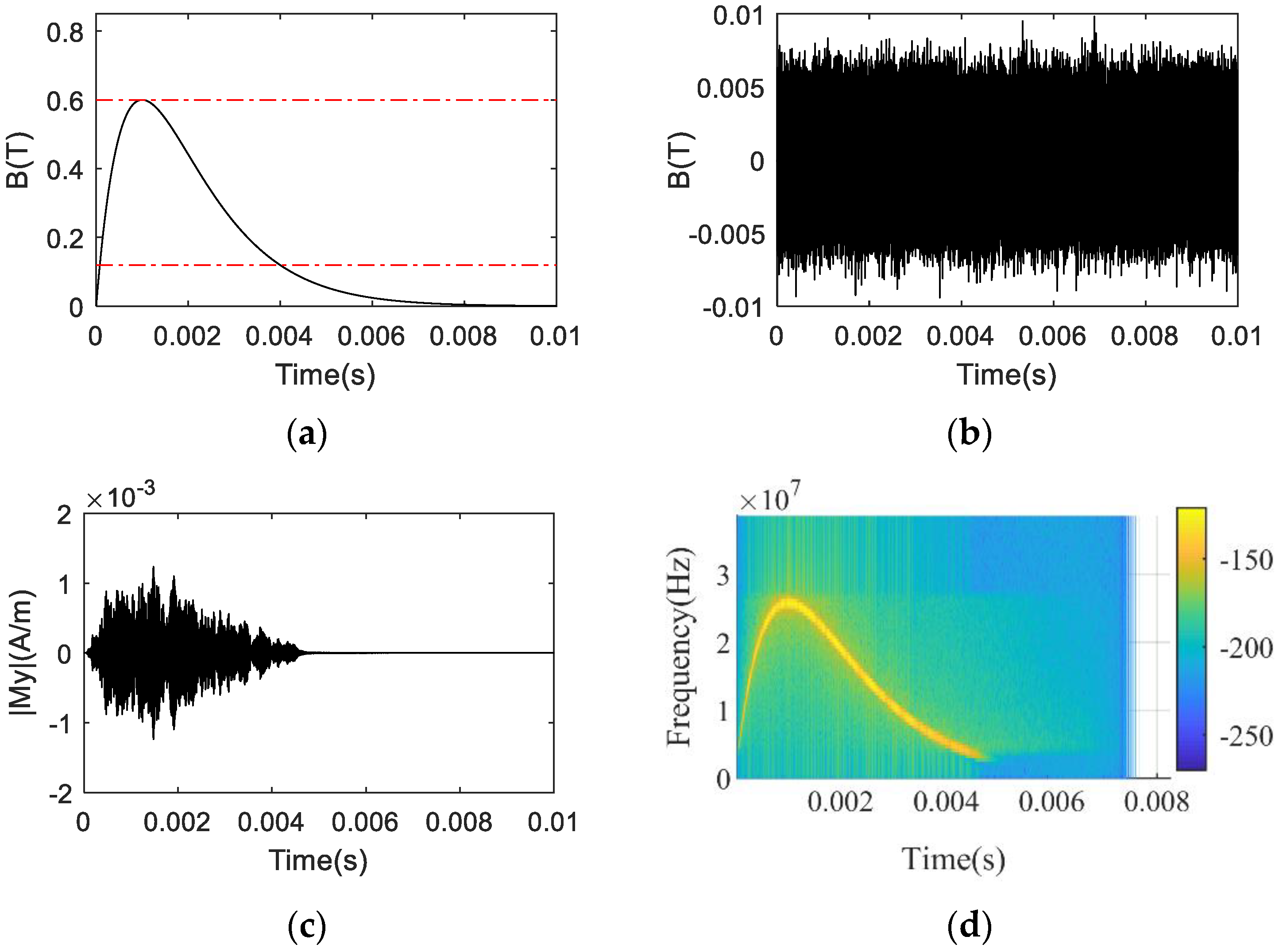

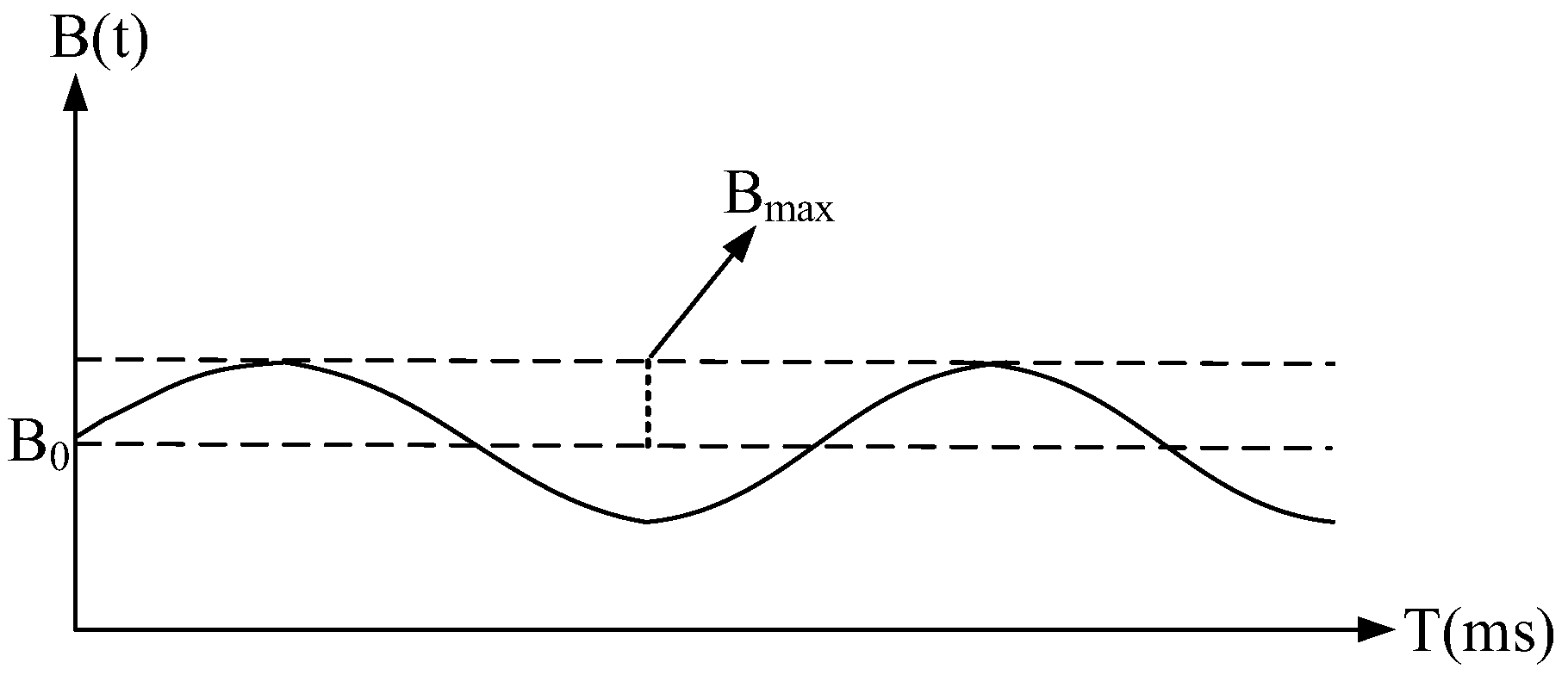




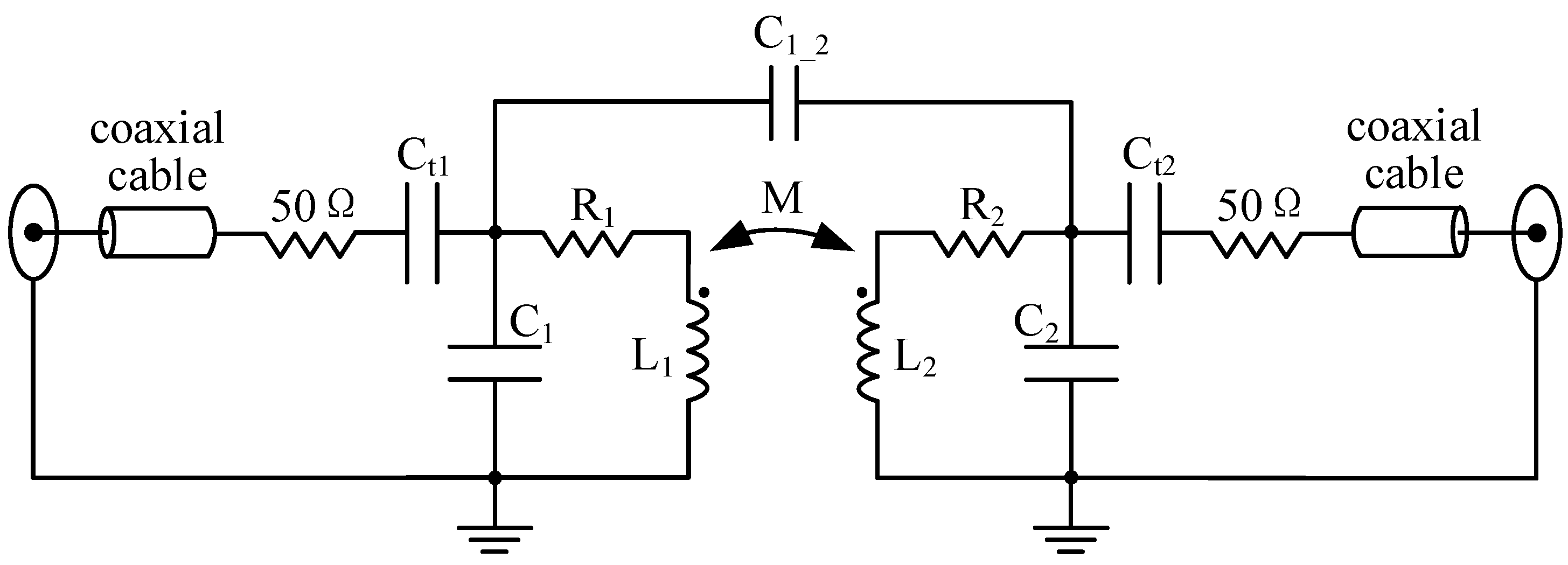
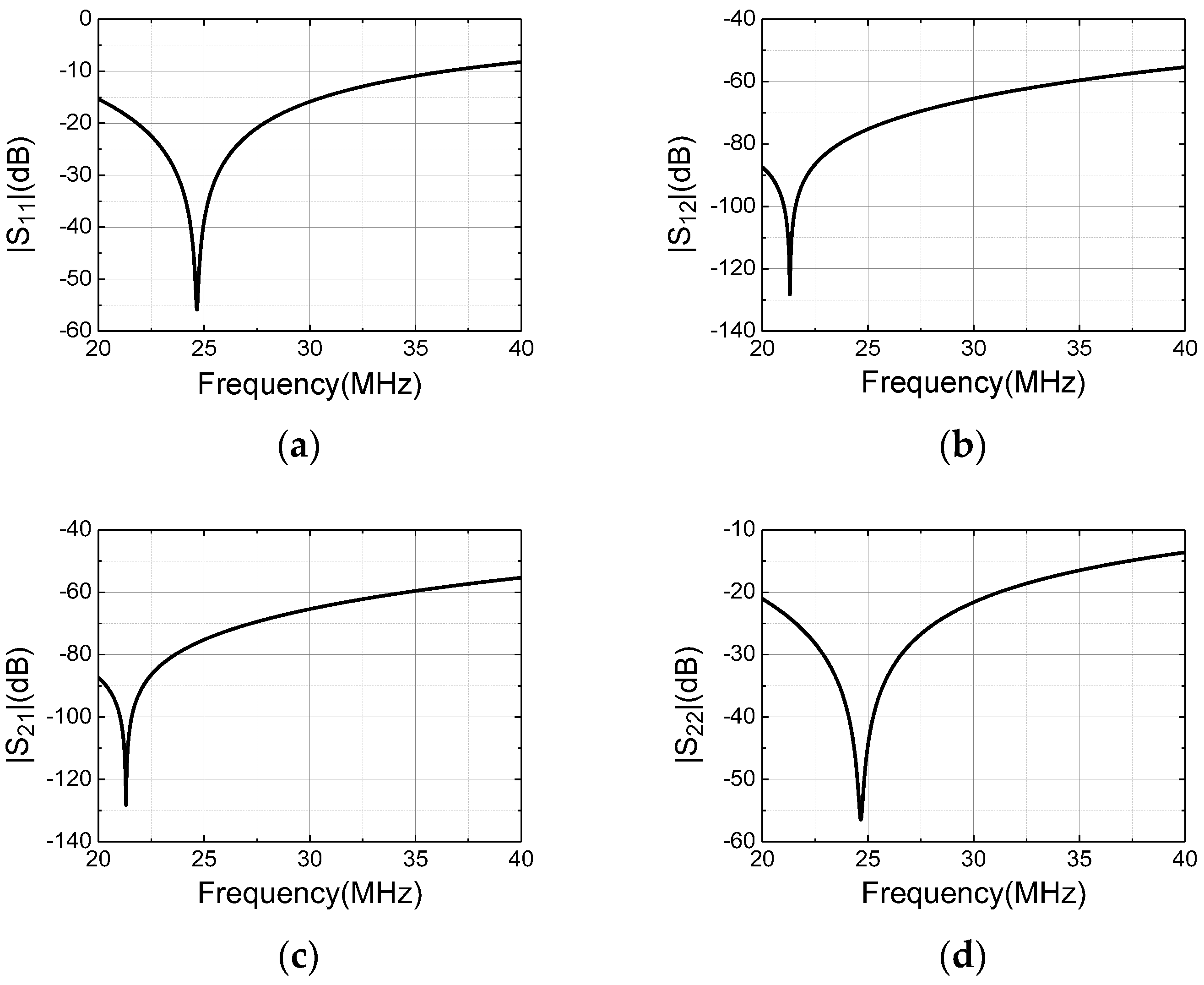

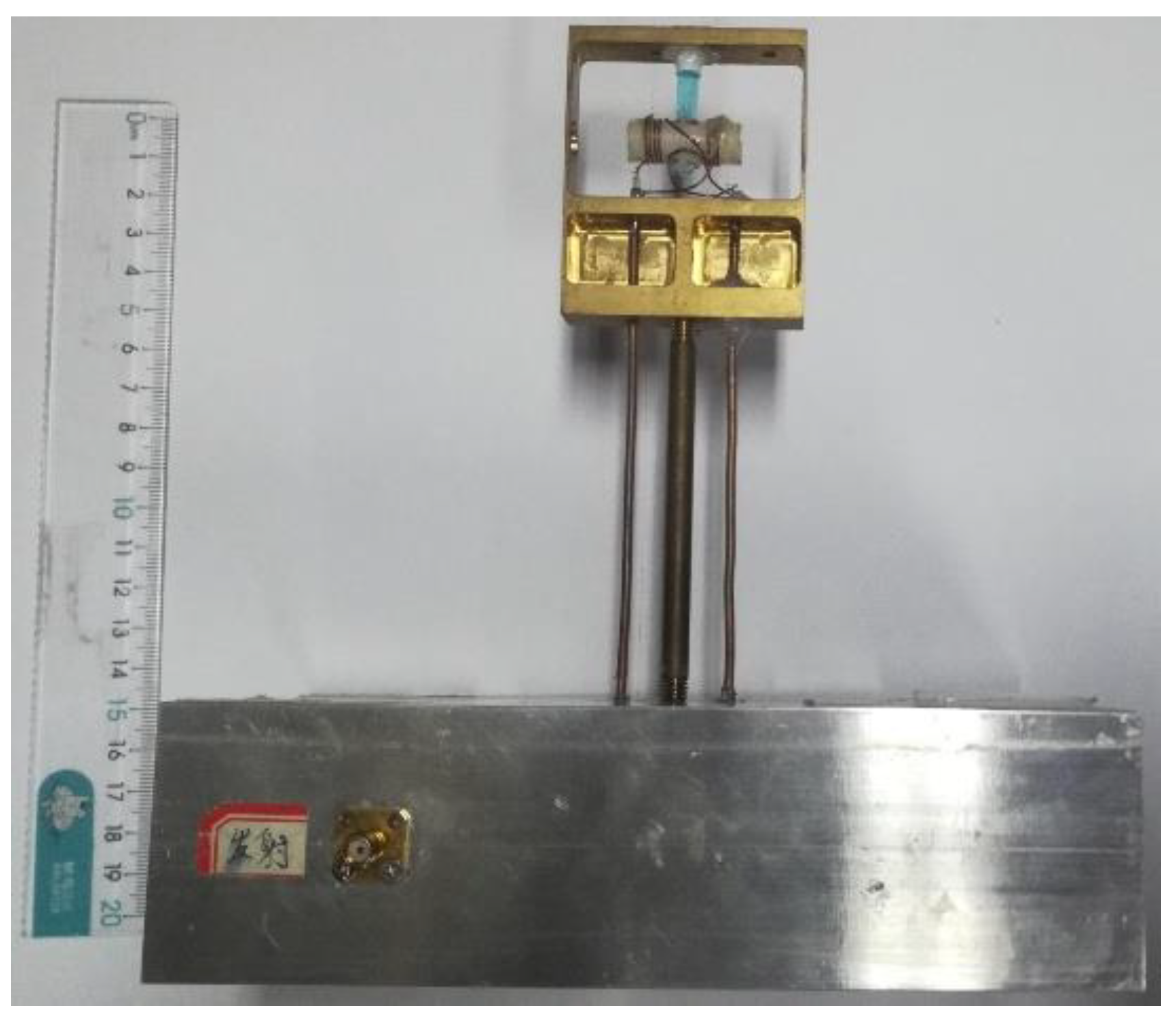


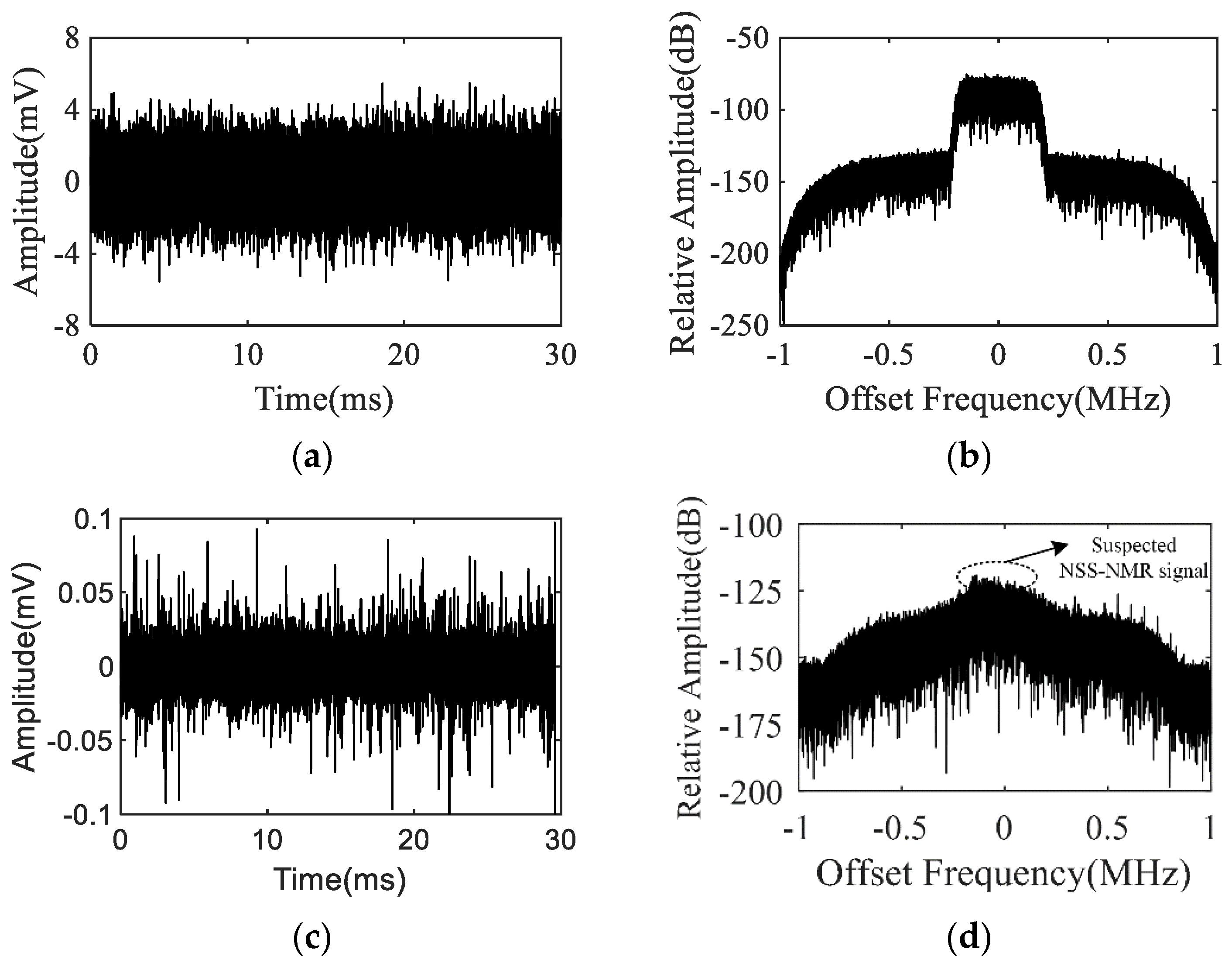
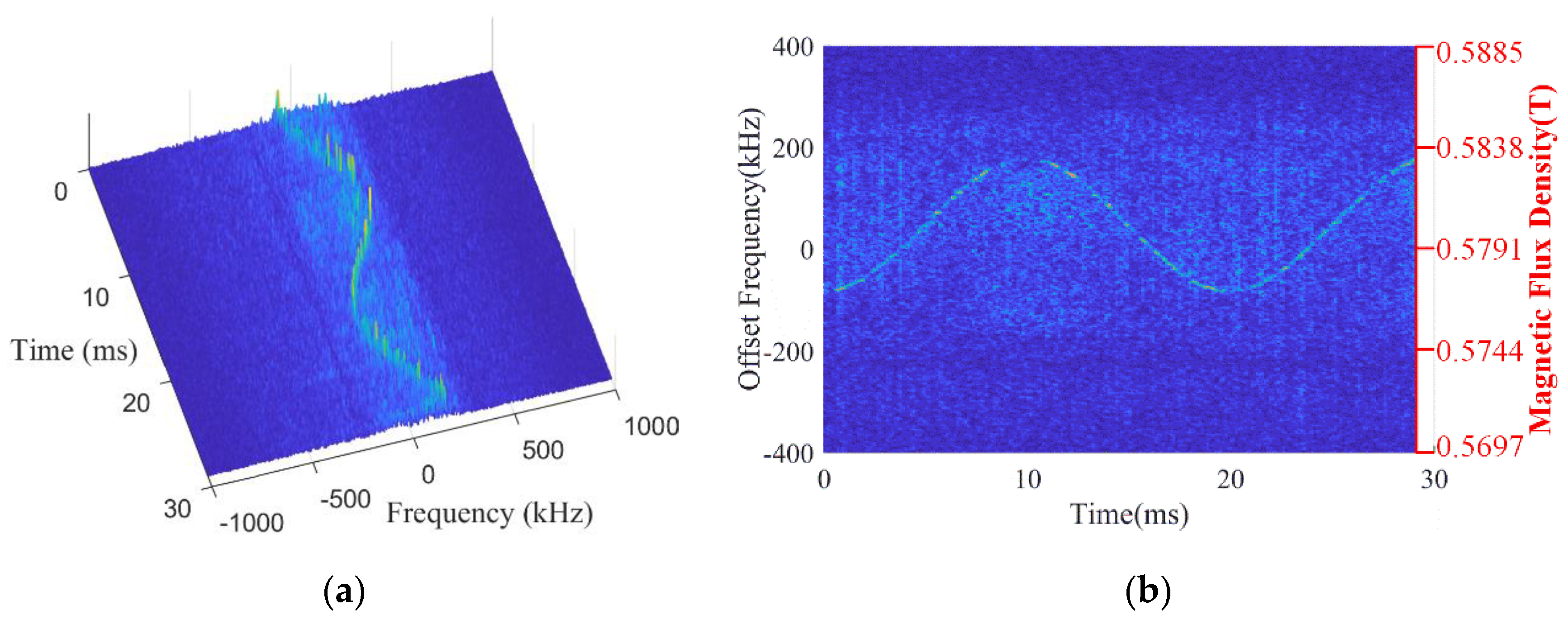
| dgap | 0.5 rcoil | rcoil | 1.5 rcoil |
|---|---|---|---|
| 0.0095 | 0.0056 | 0.0102 |
| 0.2 | 0.4 | 0.5 | 0.6 | 0.8 | |
|---|---|---|---|---|---|
| 0.011 | 0.0154 | 0.0103 | 0.0155 | 0.0318 |
| Parameters | Self- Inductance (Unit: μH) | Turn Capacitance (Unit: pF) | Ohm Resistance of Coil (Unit: mΩ) | Mutual Inductance (Unit: nH) | Mutual Capacitance (Unit: pF) |
|---|---|---|---|---|---|
| Transmitting Coil | 0.2625 | 1.145 | 18.7 | 0.29 | 0.449 |
| Receiving Coil | 0.1373 | 0.491 | 8.6 |
Publisher’s Note: MDPI stays neutral with regard to jurisdictional claims in published maps and institutional affiliations. |
© 2022 by the authors. Licensee MDPI, Basel, Switzerland. This article is an open access article distributed under the terms and conditions of the Creative Commons Attribution (CC BY) license (https://creativecommons.org/licenses/by/4.0/).
Share and Cite
Zeng, X.; Ma, H.; Jin, J.; Zhang, H.; Ma, J. Non-Steady State NMR Effect and Application on Time-Varying Magnetic Field Measurement. Sensors 2022, 22, 9960. https://doi.org/10.3390/s22249960
Zeng X, Ma H, Jin J, Zhang H, Ma J. Non-Steady State NMR Effect and Application on Time-Varying Magnetic Field Measurement. Sensors. 2022; 22(24):9960. https://doi.org/10.3390/s22249960
Chicago/Turabian StyleZeng, Xiaohu, Hong Ma, Jiang Jin, Hua Zhang, and Jingwen Ma. 2022. "Non-Steady State NMR Effect and Application on Time-Varying Magnetic Field Measurement" Sensors 22, no. 24: 9960. https://doi.org/10.3390/s22249960





